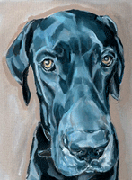notes on the Great Dane
The Great Dane, noble, robust and elegant. It has a long narrow head
with an accentuated frontal stop and a rather large nasal canal. Its
neck is long and muscular and its front legs are perfectly straight.
Its eyes are round and usually dark - with a lively intelligent expression.
Its ears are either cropped rather long, pointed, and carried erect,
or left natural. The color of the coat indicates the variety. fawn,
brindle, black, blue, mantle harlequin and sometimes Merle. However
Merle is a common result of harlequin breeding, but it is not a recognized
colour. Black coats and dark eyes, while blue Danes may have
lighter eyes.
Incised
on some Greek money dating back to 36 B.C. is the image of a dog very
similar to the Great Dane of today. The Great Dane is known as the "Apollo
of all dogs." In 407 A.D. German Gaul and part of Italy and
Spain were invaded by an Asiatic people (the Alans) who brought with
them powerful mastiff-like dogs. In Germany especially, where these
magnificent animals capable of overcoming bears and wild boars were
much admired, a process of selective breeding was begun. The dogs were
crossed with Irish Greyhounds, and the issue was the beautiful, large,
thin, agile dog known today as the Great Dane. Despite the fact that
they are called Danes in English, these dogs have nothing to do with
Denmark. Some of the Great Dane's talents are tracking, watchdog and
carting. The Great Dane is a gentle giant. Dignified, kind, sweet and
affectionate, it is playful and patient with children.

